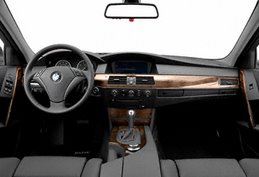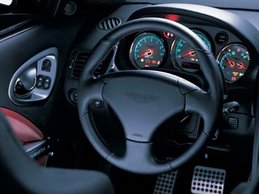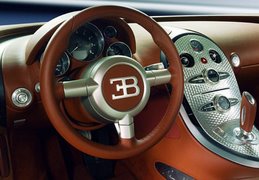 Chevrolet Malibu Maxx SS - Who’s Jeff? He is a GM man, one of the few from Generation X. He lives in the Long Island suburb of Plainview—we’re not making the name up—with his wife and new baby, his antique Cadillac, an Oldsmobile Alero, and a Chevy Malibu company car. He drives about 50,000 miles a year and goes for a spacious vehicle that doesn’t cost much and gets decent fuel economy. The Malibu Maxx SS makes him hot. “As a company rep, I aspire to that car.”
Chevrolet Malibu Maxx SS - Who’s Jeff? He is a GM man, one of the few from Generation X. He lives in the Long Island suburb of Plainview—we’re not making the name up—with his wife and new baby, his antique Cadillac, an Oldsmobile Alero, and a Chevy Malibu company car. He drives about 50,000 miles a year and goes for a spacious vehicle that doesn’t cost much and gets decent fuel economy. The Malibu Maxx SS makes him hot. “As a company rep, I aspire to that car.”True, the Maxx is already a Gauloises-smoking bohemian at the Chevrolet of baseball, hot dogs, and apple-pie fame. It rolls on GM’s front-drive Epsilon platform, which it shares with European cosmopolitans from Saab and Opel. To American eyes, the body is a somewhat runty-looking cross between a family sedan and an ice chest, but it speaks to the Continental preference for hatchbacks. The chassis is also stiff and relatively sophisticated. Check out those cast-aluminum arms in the multilink rear suspension. Were autobahns consulted in the making of the Maxx?
The SS badge is really about the engine, and at the $24,690 base price (ours had only a $325 satellite-radio receiver increasing its sticker), the Maxx SS gets more of it. This is still a 60-degree iron-block pushrod V-6—and you were expecting . . . what?—but the bores grow by three millimeters and total displacement rises from 3.5 liters to 3.9. A variable-length intake plenum optimizes airflow, and a new variable-valve-timing system rotates the cam to crack open the intake valves (and yes, the exhaust valves, too) earlier or later depending on the motion of your right foot. That’s a first for “cam in block” engines, says GM.
Snigger if you wish. Say that’s like being first out with a black-and-white plasma-screen TV, but pushrod cam phasing is a new wrinkle worth noting and a widget that even the Corvette doesn’t have.
Ultimately, easier breathing is what the fuss is about, and the 3.9 revs hard and fast with an unusually crisp song that we’re unaccustomed to in GM’s pushrod V-6s. It also doesn’t gasp at the far end of
 the tach, winding to the 6200-rpm redline with a steady, consistent push. We’d be hooting even louder if this 3.9 were making, say, the same 250 horsepower and 242 pound-feet as the overhead-cam 3.5-liter V-6 in the Saturn Vue Red Line.
the tach, winding to the 6200-rpm redline with a steady, consistent push. We’d be hooting even louder if this 3.9 were making, say, the same 250 horsepower and 242 pound-feet as the overhead-cam 3.5-liter V-6 in the Saturn Vue Red Line.Chevy gives the engine just four speeds to work with and an up-and-down button on the shifter if you want to change your own gears. After toggling into and out of overdrive a few times, the novelty wears off. The automatic’s computer doesn’t hate to downshift, so you rarely feel the need to take over. When you do, the button quickly becomes second nature to your fingers.
It’s not an American car if it can’t lay rubber. The Maxx sure does—a good 20 feet of it if you disable the traction control. Neighbor’s party kept you up last night? Blast ’em out of bed at 7 a.m. with a burnout that will set off fire alarms. More judicious control gets the Maxx through a quarter-mile of asphalt in 15.3 seconds at 91 mph, having whisked past 60 mph in 6.9 seconds. The speed governor checks in at 115 mph.
Chewing the front tires was a behavior we noted often in the base Maxx. The SS corners with far less understeer at speed, whether through extra rubber or better tuning of the suspension or both. We thought the electric motor providing the power assist was supplying unusually good feedback until we realized there’s no motor. In the Maxx SS, GM replaces the electric-power-steering servo with a hydraulic one, and the SS tracks a turn flatly and impressively faithfully to the path you aim it along. Granted, it does try to aim itself under hard acceleration, tugging at the rim with torque steer, but the change in steering hardware is definitely applause material.
You can have any interior color in the SS as long as it’s black (your exterior paint choices are silver, black, white, and Caddy-killer blue). Except for some silver-painted plastic and chrome glints here and there, the Malibu is as dark inside as a film bag. The supportive front seats are dressed in a black vinyl-and-cloth mix accented by a cross-hatch pattern that looks like it belongs in a mid-’70s Porsche. A three-spoke steering wheel with a strange but inoffensive squared-off rim adds to the sport atmosphere. Adjustable pedals are standard.
The back seat is the star, as if the designers started with a living-room love seat and put a car around it. It is spacious, with 41 inches of legroom and a bottom cushion that slides back and forth to expand the baggage capacity as needed. The rear seatback tilts to three positions, and the daylight pours in through two skylights, which have retractable shades.

If there’s a betrayal, it’s the SS’s cheap trimmings. Ragged mold partlines are everywhere. Several plastic trim pieces feel as if they were secured by bubblegum and a prayer. There’s this sense that if you turned the car over and shook it vigorously the entire interior might fall out.
Speaking of price, this SS’s $25,015 as-tested sticker (less whatever spiffs are offered this week) comes in a shade below the $25,380 of the Maxx LTZ, which has leather seats and a few other refinements but not the maximum-bore V-6. We could drone on about idle quality and interior materials, both of which are better in a Honda or Toyota. We might mention that the more agile Mazda 6 wagon costs about the same and offers a stick.













No comments:
Post a Comment